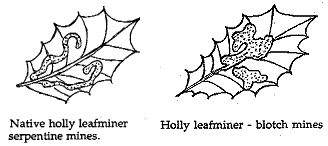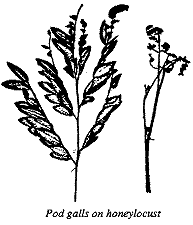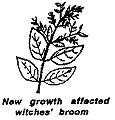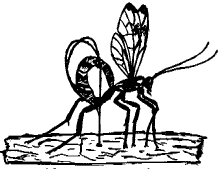|

INJURY:
Leaves of American holly, inkberry and English holly are often marked
with winding yellowish-brown mines or irregular blotches, making
plants unattractive. These symptoms are caused by small leaf feeding
maggots commonly called holly leafminers. The larvae feed between the
upper and lower leaf tissues producing the symptom called a leaf
mine.
DESCRIPTION AND LIFE HISTORY:
The adults are tiny (2.5mm) black and gray flies that appear when the
new leaves begin to develop in the spring. Adults may live only a few
days. They may injure leaves when feeding (small holes are punched in
the leaves and exuding sap is lapped up as food - the hole remains in
the leaf and upon healing looks like a tiny pit or pock mark - when
the pits are abundant, the leaf may be distorted or deformed); but
most injury occurs as a result of larval (maggot) feeding activity.
Females lay their eggs in leaf tissue causing wounds and as a result deformities occur. Larvae feed inside the protection of the leaf tissue causing blotch or serpentine mines. There are three larval stages - the larva is pale yellow, tapered front to back, and approximately 1.5mm when mature. When the larval stage is complete, transformation to the pupa occurs. The pupa is oval, approximately 2mm, red-brown in color and tapered at both ends. Adults emerge from pupae at the proper time (for most species = in the spring of the year) and the cycle begins again.
SPECIES DESCRIPTIONS:
The native holly leafminer, Phytomyza ilicicola, serpentine mines
become wider and eventually end in a terminal blotch. The egg is
inserted into underside of newly formed leaves, first appearing as
tiny green blisters on the bottom. They hatch in about 4 days and the
tiny larva immediately starts to mine. There may be multiple mines,
causing leaves to drop prematurely. The larva overwinters until March
or April when it pupates, and adults begin to emerge in May. American
holly, Ilex opaca is the preferred host.
The holly leafminer, Phytomyza ilicis, adults emerge during bloom in the spring and the females oviposit in the midrib of the leaf. The maggots hatch, feed between upper and lower leaf surfaces and by August small red spots are visible. By midwinter feeding is extensive enough that light blotches, 1/2" or greater sized are present. The larvae pupate in the leaves in late winter or early spring, and flies emerge in May. The only known host of this species is Ilex aquilifolium, English holly.
Inkberry holly leafminer, Phytomyza glabricola, is a pest on Ilex glabra, inkberry. The mines of this species overwinters as a pupa in the mine. Early literature points to two generations in New Jersey, with adults emerging in spring and again in mid-summer.
Linear holly leafminer, Phytomyza opacae damage was identified
from Long Island in August 1991. The habits of this species are
largely unknown. It has been found in Ilex opaca, I. cumulicola, I.
aquifolium var. Morris and var. Eldredge. It forms linear mines in
all three larval stages and the mines, up to 2mm wide, may transverse
the leaves several times. Adults has been found in the third week of
May in Maryland, and as late as August in Delaware.
* Family Agromyzidae
Back to Pest Information
|
|
|
|
DESCRIPTION: INJURY: |
LIFE CYCLE:
In northern New York there is normally one generation of this insect each year. In the southeastern part of the state, there may be several broods. Adult midges appear in April or May as new growth begins. They soon lay eggs which hatch into small worm-like larvae. The larvae begin feeding on young leaflets. In southeastern New York a second generation may occur on the leaves of the second flush of growth, usually the last week of June or the first week of July. The spring brood is the most troublesome.
Back to Pest Information
|
|
|
|
In 1976 reports from urban areas in Quebec, Canada, were indicating that honeysuckle was being affected by a type of witches' broom. In June and July of 1981 samples were collected from New York State. It was confirmed that this was Hyadaphis tataricae, an aphid (native to Eurasia), which was causing the symptoms. We now expect that this problem has spread throughout New York State. In Canada the literature indicates that the aphid was first introduced into the area of Montreal, undoubtedly on honeysuckle imported from Europe. |
The aphid, Hyadaphis tataricae (Aizenberg) causes the severe deformation of the growing tips by its feeding activities. At first apical leaves are curled and dwarfed, but as the season progresses the affected portion of the branches may reach several inches in length resulting in a typical witches' broom disfiguration. Eventually the stem dies. Affected plants are particularly evident in winter. The aphids are found enclosed on the upper surface of the leaves and infested leaves curl upward along the mid-rib. When populations have built up in mid to late summer, aphids are also found outside the curled leaves feeding on stems and petioles.
DESCRIPTION:
The aphids are quite small, less than 2mm in length and vary
in color from a pale green to a cream color. They feed in colonies of
up to several hundred individuals and as a result of their feeding,
growth of new shoots is slowed down considerably. Buds in axials of
leaves and branches begin to multiply rapidly causing the broom-like
effect on the tops of the branches.
LIFE CYCLE:
The entire life cycle is completed on honeysuckle, and so far,
honeysuckle is the only known host of the aphids. The aphids
overwinter as eggs on infested branch tips to hatch in the spring as
the honeysuckle begins to grow. New generations are produced
continuously throughout the summer - females giving birth to living
young, but in late August a generation of egg laying females occurs.
Eggs are deposited from September into the fall in infested areas of
the shrubs.
Back to Pest Information
|
|
|
|
Oak trees are attacked by many species of gall forming insects. The activity of these pests results in many kinds of malformed, odd appearing leaves, stems and flower growths called galls. For the most part, leaf and flower galls are not measurably injurious. However, this is not the case with many of the twig or woody galls. The horned oak gall may be seriously injurious to pin oak. Heavily galled trees may be disfigured and weakened. Some have died from the debilitating effects of the gall maker, a small cynipid wasp. LIFE HISTORY: |
WHAT IS THE OUTLOOK FOR PREVENTING
DAMAGE?
Because our information is at best very sketchy, we cannot provide a
sound recommendation for a prevention program for the horned oak gall
maker. However, here are some factors in the situation.
Gall insect parasites - Insects parasitic on the horned oak gall wasp have been found in the galls. It is possible that these parasites will contribute to a natural decline of the wasps during some of the following generations. In other words, some natural control may occur.
Natural Resistance &endash; There are pin oak trees in each of the infested areas which have not become infested with the horned oak galls. These trees do not have a single gall on them even though they are growing in the midst of infested trees. This raises the question of natural "resistance" in some trees. If not "resistance" perhaps some other factor prevents infestation of this plants. Regardless of the cause of "resistance" the occurrence of uninfested trees may offer the opportunity to develop through selection and/or breeding pin oaks which are resistant to infestation.
No insecticidal control chemical can be recommended at this time.
Where possible, cut out the galls before the horns form and destroy
them.
Back to Pest Information
|
|
|
|
DESCRIPTION: Adult horntails have a heavy body, cylindrical in shape, usually blackish or metallic blue with yellow and red markings. The males are generally smaller than the females, but often more colorful. Both sexes have four clear wings. Adults are usually 1 inch or more in length and are strong fliers. Larvae are milky white, soft-bodied and legless ranging up to 1 3/4 inches in length and are found tunneling in the wood. |
Horntails are seldom present in large enough numbers to cause significant damage. The larvae bore into the heartwood and sapwood of declining shade trees and may cause some weakening of the tree making it more susceptible to wind breakage. Pigeon tremex attacks maple, elm, beech, sycamore, hickory and others. Horntails do not damage seasoned lumber or wood structures, although they may continue to develop and emerge as adults from green sawed construction grade lumber.
LIFE HISTORY:
Adult horntails are attracted to weakened, dying or recently cut
wood. The female inserts her ovipositor as much as 3/4 inch into the
wood to lay her eggs. Eggs are laid singly, but each female is
capable of laying 300 to 400 eggs. After 3 to 4 weeks, eggs hatch and
the larvae chew their way into the sapwood and heartwood. The tunnels
are bored during the 2 to 3 year life span of the larval stage.
Tunnels may be from 1 to 2 feet in length. As the larvae chew, the
tunnels become packed with a sawdust-like material making them
difficult to see to the uninformed eye. Pupation occurs in the tunnel
made by the larva in a parchment-like cocoon. The adults emerge in
August and September and are often seen resting on a tree stump or
freshly cut pile of logs.
|
One interesting aspect of the life of Tremex columba is that there is a wasp parasite that attacks it. An ichneumon wasp female drills her long ovipositor into the wood where the horntail larva is boring. The ichneumon's ovipositor enables it to drill into the wood 3 to 4 or more inches to reach the horntail larva. She lays her eggs either on or near the horntail and the parasitic larva begins to feed. After pupation, the parasite chews its way out of the bark and may occasionally be seen resting on a tree. It is conspicuous because of its very long ovipositor (3 or more inches long). |
|

|
This site is developed and administered by Lake Technology Solutions, Inc. | www.LakeTS.com | (888) 332-8082 |




